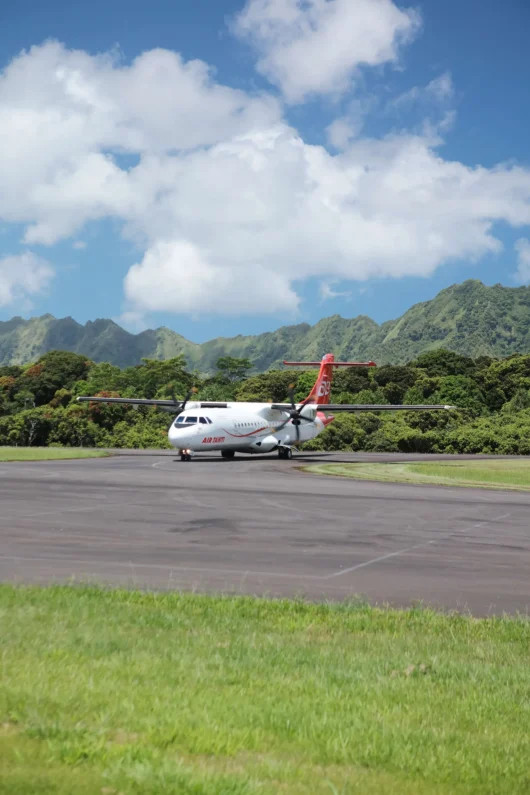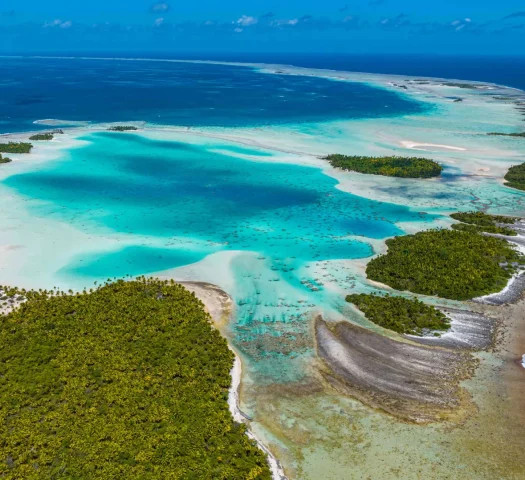Planning a trip to paradise? How To Fly To French Polynesia is a question many dreamers ask, and flyermedia.net is here to provide the answers. We will guide you through flight options, airlines, and essential travel tips to make your journey seamless. Discover the allure of the islands and get ready for an unforgettable adventure!
1. Where Exactly is French Polynesia?
French Polynesia is a collection of islands in the South Pacific Ocean. It’s located south of Hawaii, nestled between California and Australia, sharing a time zone with Hawaii. This expansive destination, also known as The Islands of Tahiti, spans an area as large as Europe and comprises 118 islands, with 76 being inhabited. The Islands of Tahiti are divided into five archipelagoes: the Society Islands, the Tuamotu Islands, the Gambier Islands, the Marquesas Islands, and the Austral Islands. Knowing where you’re headed is the first step in planning your trip, as highlighted by Tahiti Tourisme.
 Warm welcome with Raiatea flower necklace
Warm welcome with Raiatea flower necklace
2. What Airlines Fly to French Polynesia?
Several international airlines offer flights to French Polynesia, connecting major cities around the world to this tropical paradise. Airlines that fly to French Polynesia include:
- Air Tahiti Nui: The flag carrier of French Polynesia, offering direct flights from Los Angeles, Seattle, and Paris.
- United Airlines: Provides flights from San Francisco.
- Air France: Connects Paris to Papeete.
- Hawaiian Airlines: Offers flights from Honolulu.
- Air New Zealand: Operates flights from Auckland.
- LATAM Airlines: Offers flights from Santiago, Chile.
All international flights arrive at Tahiti-Faa’a International Airport (PPT), as noted by Tahiti Tourisme, the primary gateway to French Polynesia. From there, domestic airlines like Air Tahiti and Air Moana provide inter-island flights, ensuring easy access to all the islands.
3. What Are the Average Flight Times to French Polynesia?
Flight durations vary based on your departure city. Here are some average flight times to The Islands of Tahiti:
| Departure City | Average Flight Time |
|---|---|
| Paris | 22 hours |
| Los Angeles | 8 hours |
| Seattle | 10 hours |
| San Francisco | 8 hours |
| Honolulu | 5 hours |
| Nouméa | 6 hours 20 minutes |
| Tokyo | 11 hours |
| Auckland | 5 hours |
| Rarotonga | 2 hours 30 minutes |
Understanding these flight times helps you plan your itinerary and manage travel fatigue.
4. How Do I Get Around the Islands of Tahiti?
Once you arrive at Tahiti-Faa’a International Airport (PPT), you’ll need to plan your inter-island travel. Air Tahiti and Air Moana are the primary domestic airlines that provide regular flights between the islands. These airlines offer several daily flights, making it convenient to explore different islands.
According to Tahiti Tourisme, you should book both international and domestic flights in advance. Also, airport transfers should be arranged through a travel agent or directly with your accommodations.
5. What Should I Know About Customs Formalities in French Polynesia?
Understanding customs formalities is essential for a smooth entry into French Polynesia. Here are some key points:
- Passport and Visa: Ensure your passport is valid for at least six months beyond your intended stay. Visa requirements depend on your nationality, so check the specific requirements before your trip.
- Customs Declaration: Declare any items exceeding the duty-free allowance, such as alcohol, tobacco, and valuable goods.
- Biosecurity: French Polynesia has strict biosecurity regulations to protect its environment. Declare any food, plant material, or animal products.
- Currency: There are no restrictions on the amount of currency you can bring in or take out, but amounts exceeding a certain threshold must be declared.
Being prepared with the necessary documents and understanding the regulations can help you avoid any issues upon arrival. You can find more details on the official Tahiti Tourisme website.
6. What Experiences Can I Enjoy in The Islands of Tahiti?
French Polynesia offers a wide array of experiences to suit every traveler’s taste. From cultural immersion to thrilling outdoor adventures, here are some highlights:
- Cultural Sites: Explore UNESCO World Heritage Sites, visit ancient temples, and discover the rich Polynesian culture.
- Nature: Hike through lush valleys, swim in crystal-clear lagoons, and explore the diverse marine life.
- Water Activities: Enjoy snorkeling, scuba diving, surfing, and sailing in some of the world’s most beautiful waters.
- Relaxation: Unwind on pristine beaches, indulge in spa treatments, and savor delicious local cuisine.
Whether you’re seeking adventure or relaxation, French Polynesia has something for everyone.
 Quad at Belvedere
Quad at Belvedere
7. What Are the Must-Visit Islands in French Polynesia?
Each archipelago in French Polynesia offers unique attractions and experiences. Here’s a brief overview:
- Society Islands: Home to Tahiti and Bora Bora, known for their luxurious resorts, stunning landscapes, and vibrant culture.
- Tuamotu Islands: Famous for their atolls, including Rangiroa and Fakarava, offering world-class diving and snorkeling.
- Marquesas Islands: Remote and rugged, with dramatic landscapes, ancient archaeological sites, and rich Polynesian traditions.
- Austral Islands: Known for their whale-watching opportunities and authentic Polynesian culture.
- Gambier Islands: A hidden gem with a unique blend of Polynesian and Catholic influences.
Choosing the right islands to visit depends on your interests and preferences.
8. What Is the Best Time to Visit French Polynesia?
The best time to visit French Polynesia is during the dry season, which runs from May to October. During these months, you can expect pleasant temperatures, low humidity, and minimal rainfall. This makes it ideal for outdoor activities and exploring the islands.
The wet season, from November to April, can bring higher humidity and occasional tropical showers. However, this can also be a great time to visit if you’re looking for lower prices and fewer crowds.
9. What Currency Is Used in French Polynesia?
The official currency of French Polynesia is the CFP Franc (XPF). While credit cards are widely accepted in tourist areas, it’s a good idea to have some cash on hand for smaller establishments and more remote islands.
Currency exchange services are available at Tahiti-Faa’a International Airport and in major towns. ATMs are also available, but their availability may be limited on some islands.
10. What Should I Pack for a Trip to French Polynesia?
Packing appropriately can enhance your experience in French Polynesia. Here are some essentials:
- Light Clothing: Pack lightweight, breathable clothing suitable for warm weather, such as cotton or linen.
- Swimwear: Essential for enjoying the beaches and water activities.
- Sun Protection: Bring sunscreen, sunglasses, and a hat to protect yourself from the strong tropical sun.
- Insect Repellent: Mosquitoes can be prevalent, especially during the wet season.
- Water Shoes: Useful for walking on coral beaches and rocky surfaces.
- Reef-Safe Sunscreen: Protect the delicate marine ecosystem by using reef-safe sunscreen.
- Adapter: French Polynesia uses European-style plugs (Type E), so bring an adapter if needed.
- First-Aid Kit: Include basic medical supplies, such as pain relievers, antiseptic wipes, and bandages.
11. What Are Some Tips for Budgeting a Trip to French Polynesia?
French Polynesia is known for its luxury resorts, but it’s possible to visit on a budget. Here are some tips to help you save money:
- Travel During the Off-Season: Prices for flights and accommodations are typically lower during the wet season (November to April).
- Choose Budget Accommodations: Consider staying in guesthouses, pensions, or Airbnb rentals instead of luxury resorts.
- Eat Like a Local: Sample local cuisine at food trucks and markets, which are more affordable than tourist restaurants.
- Take Advantage of Free Activities: Enjoy free activities like hiking, swimming, and exploring the beaches.
- Cook Your Own Meals: If your accommodation has a kitchen, consider cooking some of your own meals to save on dining expenses.
- Use Public Transportation: Opt for local buses and ferries instead of taxis and private transfers.
- Look for Package Deals: Consider booking package deals that include flights, accommodations, and activities for potential savings.
12. What Are Some Cultural Considerations in French Polynesia?
Respecting local culture is essential for a positive travel experience. Here are some cultural considerations:
- Greetings: Learn a few basic phrases in Tahitian, such as “Ia Orana” (hello) and “Mauruuru” (thank you).
- Dress Code: While casual attire is acceptable, dress modestly when visiting religious sites and local villages.
- Tipping: Tipping is not customary in French Polynesia, but it’s always appreciated for exceptional service.
- Photography: Ask for permission before taking photos of people, especially in rural areas.
- Respect for Nature: Protect the environment by not littering, avoiding damage to coral reefs, and using reef-safe sunscreen.
- Local Customs: Be mindful of local customs and traditions, such as removing your shoes before entering a home or religious site.
13. What Are Some Essential Phrases to Know in Tahitian?
Learning a few basic phrases in Tahitian can enhance your interactions with locals. Here are some essentials:
- Ia Orana: Hello
- Mauruuru: Thank you
- Parau Farani: Do you speak French?
- Eaha te huru?: How are you?
- Maita’i: Good
- Aita: No
- ‘Ae: Yes
- Fare hea?: How much?
- Manuia: Cheers/Good health
14. What Are Some Popular Local Foods to Try in French Polynesia?
French Polynesian cuisine is a delightful blend of French, Polynesian, and Asian influences. Here are some popular dishes to try:
- Poisson Cru: Raw fish marinated in lime juice and coconut milk.
- Fafa: Chicken or octopus cooked with taro leaves and coconut milk.
- Ahima’a: Traditional Polynesian feast cooked in an underground oven.
- Poulet Fafa: Chicken cooked with taro leaves and coconut milk.
- Poe: Sweet pudding made from taro, pumpkin, or banana, cooked with coconut milk.
- Fresh Fruits: Enjoy a variety of tropical fruits, such as mangoes, papayas, and pineapples.
15. What Activities Are Available at Tahiti-Faa’a International Airport?
Tahiti-Faa’a International Airport (PPT) offers various amenities and services to make your travel experience more comfortable:
- Shops: Souvenir shops, duty-free stores, and local craft shops.
- Restaurants: Snack bars, cafes, and restaurants offering local and international cuisine.
- Currency Exchange: Exchange services for converting your currency.
- ATMs: Cash machines for withdrawing local currency.
- Tourist Information: Information counters to assist with travel queries.
- Luggage Storage: Facilities for storing your luggage.
- Wi-Fi: Free Wi-Fi access throughout the airport.
- Lounges: VIP lounges for eligible travelers.
 Air Tahiti plane on the island of Hiva Oa
Air Tahiti plane on the island of Hiva Oa
16. How Can Flyermedia.net Help Me Plan My Trip to French Polynesia?
flyermedia.net is your go-to resource for all things aviation and travel. We offer:
- Comprehensive Information: Detailed guides on airlines, airports, and destinations.
- Travel Tips: Practical advice on budgeting, packing, and cultural etiquette.
- Flight Information: Real-time updates on flight schedules and availability.
- Destination Guides: In-depth information on the best places to visit and things to do in French Polynesia.
- Aviation News: Stay up-to-date with the latest news and trends in the aviation industry.
Whether you’re a seasoned traveler or planning your first trip, flyermedia.net provides the information you need to make your journey seamless and enjoyable.
17. What Are Some of the Lesser-Known Islands Worth Visiting?
While popular islands like Bora Bora and Tahiti draw many tourists, French Polynesia has several lesser-known gems that offer a unique and authentic experience:
- Huahine: Known as the “Garden Island,” Huahine boasts lush landscapes, ancient temples, and a relaxed atmosphere.
- Maupiti: A small, unspoiled island with stunning beaches, crystal-clear waters, and a tranquil vibe.
- Tikehau: Part of the Tuamotu archipelago, Tikehau is famous for its pink sand beaches, vibrant marine life, and peaceful lagoons.
- Rurutu: Located in the Austral Islands, Rurutu is known for its whale-watching opportunities and unique limestone formations.
- Fakarava: A UNESCO Biosphere Reserve, Fakarava offers world-class diving, pristine coral reefs, and diverse wildlife.
These islands provide a more intimate and off-the-beaten-path experience, perfect for travelers seeking adventure and tranquility.
18. How Can I Stay Connected in French Polynesia?
Staying connected in French Polynesia is relatively easy, with various options available:
- Mobile Data: Purchase a local SIM card from a mobile carrier such as Vini or Vodafone.
- Wi-Fi: Many hotels, resorts, and cafes offer free Wi-Fi access.
- Pocket Wi-Fi: Rent a pocket Wi-Fi device for convenient and portable internet access.
- International Roaming: Check with your mobile provider about international roaming plans.
Keep in mind that internet speeds and coverage may vary, especially on more remote islands.
19. What Types of Accommodation Are Available in French Polynesia?
French Polynesia offers a wide range of accommodation options to suit every budget and preference:
- Luxury Resorts: Overwater bungalows, beachfront villas, and world-class amenities.
- Mid-Range Hotels: Comfortable rooms, swimming pools, and convenient locations.
- Guesthouses and Pensions: Affordable options with a local touch, often run by families.
- Airbnb: Apartments, houses, and private rooms for a more independent experience.
- Motels: Budget-friendly accommodations with basic amenities.
Choosing the right accommodation depends on your budget, travel style, and desired level of comfort.
20. What Are Some Safety Tips for Traveling in French Polynesia?
French Polynesia is generally a safe destination, but it’s always wise to take precautions:
- Secure Your Belongings: Keep your valuables in a safe place and be mindful of your surroundings.
- Swim Safely: Swim in designated areas and be aware of currents and marine life.
- Stay Hydrated: Drink plenty of water to avoid dehydration in the tropical climate.
- Protect Against Mosquitoes: Use insect repellent and wear long sleeves and pants in the evenings.
- Respect Local Customs: Be respectful of local traditions and customs.
- Travel Insurance: Purchase travel insurance to protect against unexpected events.
21. How to Fly to French Polynesia: What are the Visa Requirements?
Visa requirements depend on your nationality and the length of your stay. Citizens of many countries, including the United States, Canada, and the European Union, can enter French Polynesia for up to 90 days without a visa. However, it’s essential to check the specific requirements based on your nationality before your trip. You can find detailed information on the French Embassy or Consulate website in your country.
22. How to Fly to French Polynesia: What Kind of Plugs are Used?
French Polynesia uses European-style plugs (Type E). These plugs have two round pins and a hole for the grounding pin. If you’re traveling from the United States, Canada, or other countries with different plug types, you’ll need to bring a plug adapter. You can purchase these adapters at most travel stores or online.
23. How to Fly to French Polynesia: Are There Sharks in the Water?
Yes, there are sharks in the waters around French Polynesia, but shark attacks are rare. Most sharks are harmless reef sharks that pose no threat to humans. However, it’s always wise to be cautious when swimming or diving in the ocean. Follow these tips:
- Swim in designated areas.
- Avoid swimming at dawn or dusk, when sharks are most active.
- Don’t wear shiny jewelry, which can attract sharks.
- Don’t feed the sharks.
- Follow the instructions of local guides and dive operators.
24. How to Fly to French Polynesia: What is the Time Zone?
French Polynesia has several time zones, depending on the specific island group. The most common time zone is Tahiti Time (TAHT), which is UTC-10. This means that French Polynesia is 10 hours behind Coordinated Universal Time (UTC). It’s essential to check the time zone of the specific island you’re visiting to avoid confusion.
25. How to Fly to French Polynesia: What Kind of Weather to Expect?
French Polynesia has a tropical climate with warm temperatures year-round. The average temperature ranges from 70°F to 85°F (21°C to 29°C). The dry season (May to October) is characterized by sunny skies and low humidity, while the wet season (November to April) can bring higher humidity and occasional tropical showers. It’s essential to pack light, breathable clothing and be prepared for both sunny and rainy conditions.
26. How to Fly to French Polynesia: What are Some Unique Souvenirs to Buy?
French Polynesia offers a variety of unique souvenirs that reflect the local culture and traditions:
- Black Pearls: Known for their beauty and rarity, black pearls are a popular souvenir from French Polynesia.
- Tiki Carvings: These traditional Polynesian carvings represent gods and ancestors.
- Monoi Oil: Made from coconut oil and Tiare flowers, Monoi oil is used for skincare and haircare.
- Pareos: Colorful wraps that can be worn as clothing or used as home decor.
- Ukuleles: These small, guitar-like instruments are a symbol of Polynesian music.
- Handmade Crafts: Local artisans create a variety of crafts, such as woven baskets, wood carvings, and jewelry.
27. How to Fly to French Polynesia: How Can I Learn More About the Local Culture?
There are many ways to immerse yourself in the local culture of French Polynesia:
- Visit Cultural Sites: Explore ancient temples, museums, and historical sites.
- Attend Festivals: Participate in local festivals and celebrations.
- Take a Cultural Tour: Guided tours can provide insights into Polynesian traditions and customs.
- Learn the Language: Learning a few basic phrases in Tahitian can enhance your interactions with locals.
- Try Local Cuisine: Sample traditional dishes and learn about the culinary heritage of French Polynesia.
- Respect Local Customs: Be mindful of local customs and traditions.
28. How to Fly to French Polynesia: What are the Best Beaches?
French Polynesia is home to some of the world’s most beautiful beaches. Here are some of the best:
- Matira Beach, Bora Bora: Known for its soft white sand and crystal-clear waters.
- Pink Sand Beach, Tikehau: Famous for its unique pink sand and vibrant marine life.
- Plage de Temae, Moorea: A beautiful beach with stunning views of Tahiti.
- Les Sables Roses, Fakarava: A remote beach with pink sand and turquoise waters.
- Tereia Beach, Maupiti: A secluded beach with pristine sand and clear waters.
 Aerial view of Rangiroa
Aerial view of Rangiroa
29. How to Fly to French Polynesia: What Water Sports are Available?
French Polynesia offers a wide range of water sports activities:
- Snorkeling: Explore the vibrant coral reefs and marine life.
- Scuba Diving: Discover underwater caves, shipwrecks, and diverse marine species.
- Surfing: Catch some waves at popular surf spots.
- Sailing: Explore the islands by boat and enjoy the stunning scenery.
- Kayaking: Paddle through calm lagoons and discover hidden coves.
- Paddleboarding: Enjoy a relaxing paddle on the calm waters.
- Jet Skiing: Explore the coastline and enjoy the thrill of jet skiing.
- Kite Surfing: Take advantage of the windy conditions for kite surfing.
30. How to Fly to French Polynesia: What Kind of Wildlife Can I See?
French Polynesia is home to a diverse range of wildlife:
- Marine Life: Colorful fish, sea turtles, dolphins, sharks, and whales.
- Birds: Tropical birds such as parrots, frigatebirds, and terns.
- Land Animals: Lizards, geckos, and domesticated animals.
- Insects: Mosquitoes, butterflies, and other tropical insects.
31. How to Fly to French Polynesia: What are Some Activities for Nature Lovers?
If you’re a nature lover, French Polynesia offers plenty of activities:
- Hiking: Explore lush valleys, waterfalls, and mountain trails.
- Whale Watching: Observe humpback whales during their migration season.
- Botanical Gardens: Visit botanical gardens and learn about local plants.
- Eco-Tours: Participate in eco-tours that focus on conservation and sustainability.
- Bird Watching: Spot tropical birds in their natural habitat.
- Snorkeling and Diving: Explore the vibrant coral reefs and marine life.
32. How to Fly to French Polynesia: What Are Some Sustainable Tourism Practices to Keep in Mind?
To help preserve the natural beauty of French Polynesia, consider the following sustainable tourism practices:
- Use Reef-Safe Sunscreen: Protect coral reefs by using sunscreen that doesn’t contain harmful chemicals.
- Avoid Single-Use Plastics: Bring your own reusable water bottle, shopping bag, and utensils.
- Respect Local Culture: Be mindful of local traditions and customs.
- Support Local Businesses: Shop at local markets and eat at local restaurants.
- Conserve Water and Energy: Be mindful of your water and energy consumption.
- Dispose of Waste Properly: Dispose of your waste in designated bins and avoid littering.
- Choose Eco-Friendly Tours: Support tour operators that follow sustainable practices.
33. How to Fly to French Polynesia: What Should I Know About Health and Safety?
When traveling to French Polynesia, keep the following health and safety tips in mind:
- Consult Your Doctor: Talk to your doctor about any necessary vaccinations or health precautions.
- Travel Insurance: Purchase travel insurance to protect against unexpected events.
- Stay Hydrated: Drink plenty of water to avoid dehydration.
- Protect Against Mosquitoes: Use insect repellent and wear long sleeves and pants in the evenings.
- Food and Water Safety: Eat at reputable establishments and drink bottled or purified water.
- Sun Protection: Use sunscreen, sunglasses, and a hat to protect yourself from the sun.
- Swim Safely: Swim in designated areas and be aware of currents and marine life.
- Secure Your Belongings: Keep your valuables in a safe place and be mindful of your surroundings.
34. How to Fly to French Polynesia: What are Some Popular Itineraries?
Here are some popular itineraries for exploring French Polynesia:
- Bora Bora and Moorea: Spend a week exploring the luxurious resorts and stunning landscapes of Bora Bora and Moorea.
- Tahiti and the Society Islands: Discover the culture and beauty of Tahiti and explore other islands in the Society archipelago.
- Tuamotu Atolls: Dive into the world-class diving and snorkeling opportunities in the Tuamotu atolls.
- Marquesas Islands Adventure: Explore the remote and rugged landscapes of the Marquesas Islands.
- Multi-Island Hopping: Combine several islands for a diverse and unforgettable experience.
35. How to Fly to French Polynesia: FAQ
- What is the main airport in French Polynesia?
Tahiti-Faa’a International Airport (PPT) is the main airport in French Polynesia. - Do I need a visa to visit French Polynesia?
Visa requirements depend on your nationality; many countries can enter for up to 90 days without a visa. - What currency is used in French Polynesia?
The CFP Franc (XPF) is the official currency. - What is the best time to visit French Polynesia?
The dry season (May to October) is the best time to visit. - What languages are spoken in French Polynesia?
French and Tahitian are the official languages. - Are credit cards widely accepted in French Polynesia?
Yes, credit cards are widely accepted in tourist areas. - Is it safe to drink tap water in French Polynesia?
It is recommended to drink bottled or purified water. - What should I pack for a trip to French Polynesia?
Light clothing, swimwear, sunscreen, insect repellent, and a hat are essential. - What are some popular activities in French Polynesia?
Snorkeling, diving, hiking, and whale watching are popular activities. - How can flyermedia.net help me plan my trip to French Polynesia?
flyermedia.net provides comprehensive information on airlines, airports, destinations, and travel tips.
36. Ready to Explore French Polynesia?
Now that you know how to fly to French Polynesia, it’s time to start planning your dream trip. Visit flyermedia.net for more detailed guides, travel tips, and aviation news to make your journey unforgettable. Whether you’re seeking adventure, relaxation, or cultural immersion, French Polynesia has something for everyone.
Are you ready to discover the beauty of The Islands of Tahiti? Head over to flyermedia.net now to find the information you need to make your travel dreams a reality. Explore our comprehensive guides on airlines, airports, destinations, and travel tips. Let us help you plan your adventure and make your journey seamless and enjoyable. Don’t wait; paradise awaits.